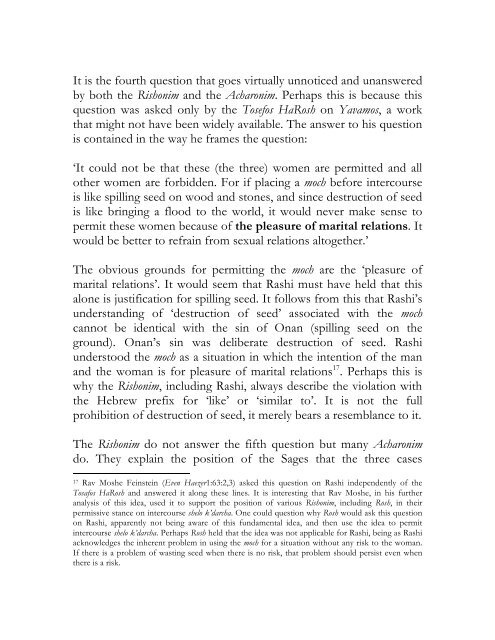Contraception in Contemporary Orthodox Judaism
Contraception in Contemporary Orthodox Judaism
Contraception in Contemporary Orthodox Judaism
You also want an ePaper? Increase the reach of your titles
YUMPU automatically turns print PDFs into web optimized ePapers that Google loves.
It is the fourth question that goes virtually unnoticed and unanswered<br />
by both the Rishonim and the Acharonim. Perhaps this is because this<br />
question was asked only by the Tosefos HaRosh on Yavamos, a work<br />
that might not have been widely available. The answer to his question<br />
is conta<strong>in</strong>ed <strong>in</strong> the way he frames the question:<br />
‘It could not be that these (the three) women are permitted and all<br />
other women are forbidden. For if plac<strong>in</strong>g a moch before <strong>in</strong>tercourse<br />
is like spill<strong>in</strong>g seed on wood and stones, and s<strong>in</strong>ce destruction of seed<br />
is like br<strong>in</strong>g<strong>in</strong>g a flood to the world, it would never make sense to<br />
permit these women because of the pleasure of marital relations. It<br />
would be better to refra<strong>in</strong> from sexual relations altogether.’<br />
The obvious grounds for permitt<strong>in</strong>g the moch are the ‘pleasure of<br />
marital relations’. It would seem that Rashi must have held that this<br />
alone is justification for spill<strong>in</strong>g seed. It follows from this that Rashi’s<br />
understand<strong>in</strong>g of ‘destruction of seed’ associated with the moch<br />
cannot be identical with the s<strong>in</strong> of Onan (spill<strong>in</strong>g seed on the<br />
ground). Onan’s s<strong>in</strong> was deliberate destruction of seed. Rashi<br />
understood the moch as a situation <strong>in</strong> which the <strong>in</strong>tention of the man<br />
and the woman is for pleasure of marital relations 17 . Perhaps this is<br />
why the Rishonim, <strong>in</strong>clud<strong>in</strong>g Rashi, always describe the violation with<br />
the Hebrew prefix for ‘like’ or ‘similar to’. It is not the full<br />
prohibition of destruction of seed, it merely bears a resemblance to it.<br />
The Rishonim do not answer the fifth question but many Acharonim<br />
do. They expla<strong>in</strong> the position of the Sages that the three cases<br />
17 Rav Moshe Fe<strong>in</strong>ste<strong>in</strong> (Even Haezer1:63:2,3) asked this question on Rashi <strong>in</strong>dependently of the<br />
Tosafos HaRosh and answered it along these l<strong>in</strong>es. It is <strong>in</strong>terest<strong>in</strong>g that Rav Moshe, <strong>in</strong> his further<br />
analysis of this idea, used it to support the position of various Rishonim, <strong>in</strong>clud<strong>in</strong>g Rosh, <strong>in</strong> their<br />
permissive stance on <strong>in</strong>tercourse shelo k’darcha. One could question why Rosh would ask this question<br />
on Rashi, apparently not be<strong>in</strong>g aware of this fundamental idea, and then use the idea to permit<br />
<strong>in</strong>tercourse shelo k’darcha. Perhaps Rosh held that the idea was not applicable for Rashi, be<strong>in</strong>g as Rashi<br />
acknowledges the <strong>in</strong>herent problem <strong>in</strong> us<strong>in</strong>g the moch for a situation without any risk to the woman.<br />
If there is a problem of wast<strong>in</strong>g seed when there is no risk, that problem should persist even when<br />
there is a risk.





